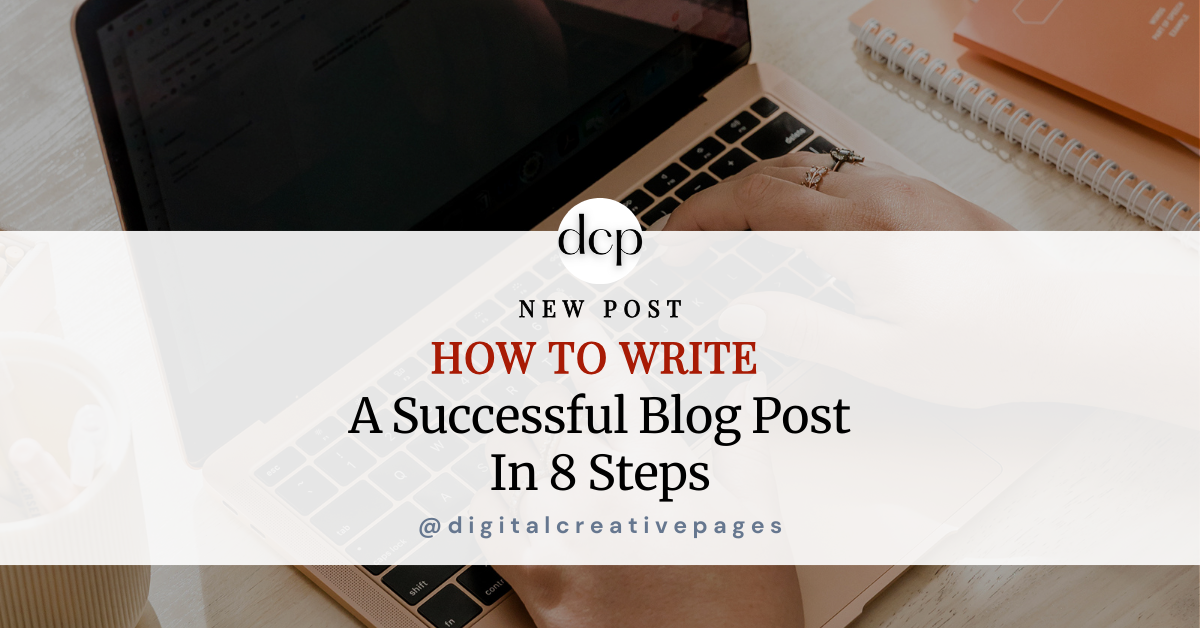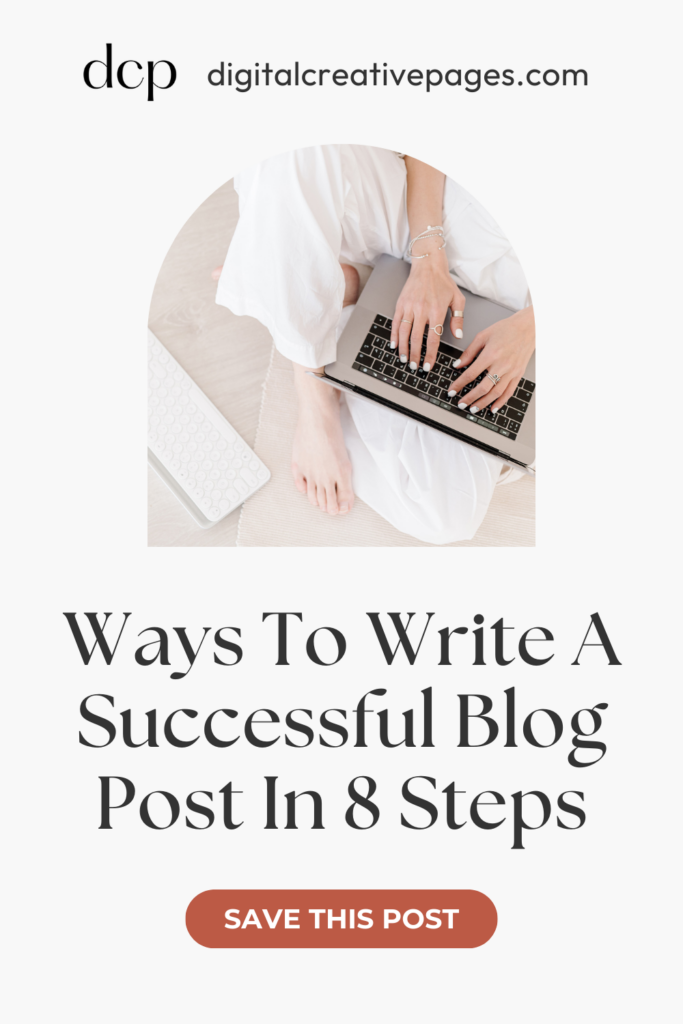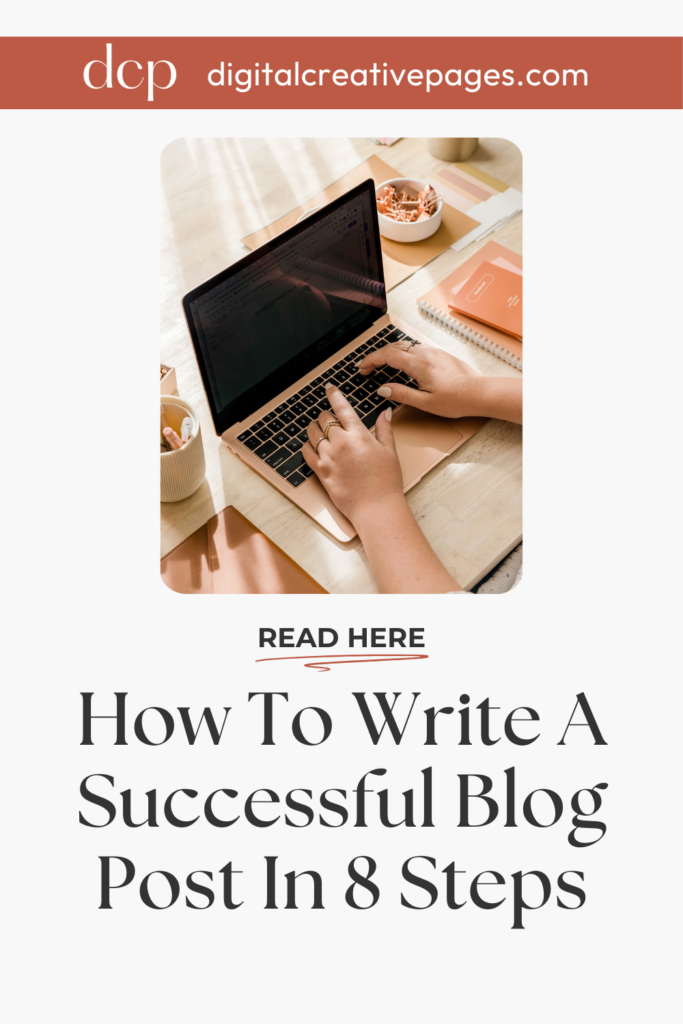Hey there. Want to write a blog post that gets read, shared, and remembered but are struggling to get it right? Don’t worry. I’ve got your back. There are at the minimum 8 steps that will show you how to write a successful blog post. If you conquer all of them, you can make your post stand out and those reading it would feel as if you have answered their question.
Love this? Pin it for later
If you’re a service-based business owner, aspiring content creator, or coach, you do know the crafting a blog post takes up a huge chunk of your time that you need for your business. My aim is to have this blog post give you a formula to write a good piece, cutting through the confusion. Your main aim to writing blog posts is to not only provide value but also build trust and convert readers into loyal clients.
A well-crafted blog post isn’t just about filling up a page with words. It’s a strategic tool that can educate, inspire, entertain, or persuade your audience. The formula below simplifies the blog writing process so that even if you’re short on time or experience, you can create content that performs.
1. Choose a Question Your Ideal Reader is Already Asking
Every great blog post starts with a topic that solves a real problem. If you’re guessing what your audience needs, you’re missing an opportunity to connect deeply. The best-performing posts usually come from real-life questions—ones your audience is already typing into search engines. Don’t use broad topics because they have been answered by many. Niche it down so it answers one specific question for one targeted audience.
Why this works
It ensures your post meets a genuine need. When your blog content answers real questions, it’s more likely to be saved, shared, and ranked well on search engines like Google and Pinterest.
Where to find these questions:
- The search bar on Pinterest or Google (look at the autocomplete suggestions!)
- ‘People Also Ask’ section on Google
- Comments and DMs on your social platforms
- Facebook group posts in your niche
- Tools like Answer the Public or AlsoAsked
Example: If you’re a Pinterest manager, your ideal reader might be asking: “How do I get more traffic to my site using Pinterest in 2025?” That’s your blog title right there.
Pro Tip: Save a folder or doc with all these FAQs you find—they’re future blog posts waiting to happen.
2. Do Smart Keyword Research (But Don’t Get Stuck Here)
SEO matters—but don’t let it paralyze you. Focus on finding 1–2 primary keywords and a few long-tail versions. These will help your post get discovered and rank over time. As explained above, use Google’s People Also Ask and Pinterest search to get the search phrases.
How to find your keywords:
- Ubersuggest: Great for long-tail keywords
- Keywords Everywhere: Shows volume and competition right in your browser
- Pinterest Trends: Ideal for seasonal content if your audience is active on Pinterest
Where to place keywords:
- Title and URL slug
- First 100 words of the post
- Subheadings, where it fits naturally
- Meta description (for SEO plugins like Yoast)
- Image alt text
Pro Tip: Always write like a human in a friendly manner. A post stuffed with keywords will push readers away. Use them naturally—like how your audience would search.
3. Create a Clear Outline Before You Start Writing
If you’re staring at a blank screen, it’s probably because you have skipped this step. Don’t freestyle it. An outline gives structure and saves you tons of editing time later.
Simple blog post outline:
- Headline (with your keyword!)
- Introduction (hook your reader + tease what they’ll learn)
- Main Points (usually 3–5 sections with headers + bullets or examples)
- CTA (what’s the next step you want them to take?)
To write the perfect headline, I use MonsterInsights as that is the only site which gives you examples of power words, emotional words, and uncommon words. Just ensure the headline also contains a short tail SEO keyword.
Example: If you’re writing about Pinterest traffic, your 3 main points might be: Optimize your profile, design scroll-stopping pins, and use keyword-rich boards.
If you sell templates or offer services: Mention them where relevant. Example: If one of your main points is “Design better graphics,” and you sell Pinterest templates—link to them!
Pro Tip: Use your outline to break writer’s block. Start with bullet points under each section, then fill in the details.
4. Write a Captivating Introduction
You’ve got 3 seconds to grab attention—make them count. Start with something bold, relatable, or unexpected to hook your reader fast. Aim to stir emotion or spark curiosity right away. Your hook should speak directly to what your reader is thinking or struggling with.
Have your keyword and the title of your blog post in the first paragraph. Ensure that the lines grab the reader’s attention and gives them the gist of the problem solved. Making it relatable would ensure they would save the post.
What makes a strong intro:
- A bold or relatable opening line
- Empathy for your reader’s challenge
- A preview of what they’ll get if they keep going
Example: “Tired of pouring hours into Pinterest with little traffic to show for it? You’re not alone. In this post, I’ll walk you through five easy tweaks you can make this week that can change everything.”
Keep it light, conversational, and you.
Pro Tip: If you’re stuck on your intro, write the body first. Then go back and write your hook with more clarity.
Pin this for later
5. Deliver Real Value in the Body of Your Post
This is where you serve. Forget fluff—give your readers insights, shortcuts, tools, and examples they can actually use. Make every sentence do the work of answering a question or solving a pain point. Show them you understand their world and can offer real solutions.
For the body, I usually divide them into points or categories and write a few lines explaining the category and then bullet points. At least have 2 or 3 bullet points. Having bullet points breaks up the wall of prose and helps snag a reader’s focus. Sharing your own personal experience, if you have them, would help too.
Ways to add real value:
- Break up your content with H2 and H3 headers
- Use bullet points or numbered steps
- Link to other blog posts or service pages
- Add screenshots, examples, or personal stories
- Embed a checklist or downloadable lead magnet
Example: If you’re teaching readers how to write SEO-friendly blog posts, link them to your Pinterest templates or your eBook about passive blog traffic.
Pro Tip: One post = one goal. Don’t try to teach everything in one go. Go deep, not wide.
6. Include a Strong Call-to-Action (CTA)
You’ve earned their attention—don’t let it go to waste. Always guide your reader to a clear next step. I am guilty of forgetting this step, though I am making a point to have them in my future posts. Summarize the post where possible as points and direct the reader’s attention to what you want them to do next.
CTA ideas:
- “Download my free blog post checklist”
- “Looking for help with Pinterest? Book a free discovery call.”
- “If this helped you, leave a comment below!”
Your CTA should match the intention of the post. Educational = download. Personal story = invite engagement. Case study = direct them to your service.
Pro Tip: CTAs don’t always have to be at the end. Try sprinkling them throughout the post where they feel natural. Also entice them to use the sharing button to share your posts on any or all social media. I find more clicks to my blog post via X formerly known as Twitter.
7. Edit Ruthlessly & Format Like a Pro
Never hit publish on your first draft. Once you finish your first draft, take your time to flesh it out. Sometimes a break for an hour or two would help. Don’t always be in a hurry to brag that you could hammer out 5 blog posts in one hour. They sound exciting, but do they really get the footfalls you would like?
Great blog posts are made during the editing stage. Make it a point to scrutinize every line of your post. Even the greatest proofreader might miss a typo or two. Don’t panic if someone uses the contact page to point out the mistakes. Remember, mistakes mean the post has been written by a human.
Go one step further to optimize your blog post for SEO during this editing stage. Weave the keywords organically in your post. Optimize your images too for the correct size and title with keywords. I generally use Styled Stock Society for most of my images on the blog post. Try them using my affiliate link – HERE.
Editing checklist:
- Read it out loud (you’ll catch awkward phrasing)
- Remove fluff (be ruthless—cut anything that doesn’t serve your reader)
- Check for grammar and typos (use Grammarly or Hemingway)
- Shorten your paragraphs (2–3 lines max!)
Formatting tips:
- Use bold or italic for emphasis
- Add plenty of white space.
- Break up the wall of text with images or headings.
- Use high-quality, branded images
- Make sure your headings are consistent
- Add internal and external links
- Add affiliate link with clear disclaimer
- A problem-solving lead magnet relevant to the blog post also helps.
Each blog post has its own format. It took me a few tries to get down to the format I liked. And now I stay consistent to this. It also helps your readers get used to your format and makes your post instantly recognizable.
Pro Tip: Design your blog to be skim-friendly. Most readers scan before they commit. Have a couple of Pinterest pin images that can be shared. I usually post 3.
8. Infuse Your Personality & Brand Voice
People buy from people they trust. And trust comes from connection. Let your voice shine through your writing. Make your blog post sound personal. I have seen this on my blog posts too. Where I just inform, hardly anyone reads it. And where I add my own anecdotes, I get more footfalls.
Ways to show personality:
- Share short stories or examples from your own business
- Use words and phrases you actually say (ditch the jargon!)
- Show empathy, humor, or inspiration
- Let your mission or values guide your tone
Example: “As a book editor and beta reader, I know how scary it can feel to hit ‘publish’ on anything. But blog posts are a low-risk way to build your confidence and your audience.”
Pro Tip: Don’t try to sound like someone else. The more YOU you are, the more magnetic your writing becomes. Give your blog post a final look-over using the PREVIEW button and then hit PUBLISH
Final Thoughts
Blogging doesn’t have to be overwhelming. With the right structure and strategy, you can create content that works hard for your business. You can use AI judiciously, but don’t allow it to take over your posts. Get your outlines with headlines done by it, but do your own keyword research. Ask AI for the final reviewing for suggestions of any points you might be missing, but use your own words to write them out. That will transform an ordinary post into an EXTRAordinary one. There is after all only one of YOU.
What To Do Next After Publishing?
Promote. Then promote more. Keep promoting always. I used to be slack about it. But now I am back to actively sharing my blog posts, especially on X, formerly known as Twitter.
A few steps you can take that I usually do
- Share it on all social media you are active on
- Add the link of this post to the older, relevant blog posts. At least 5 to 10
- Pin a Pinterest Image from the blog post to a relevant board
- I also share it on my Digital Content Newsletter. If you are not part of my tribe, join in. The form is right below.
- This is something I have recently started doing. Submit your blog URL to Google Search Console and request for indexing.
Let’s recap the 8 blog post steps:
- Start with a question your audience is already asking
- Do keyword research that supports, not distracts
- Outline your post before you start writing
- Hook your readers with a great intro
- Deliver value in the body with examples and bullet points
- Include clear calls-to-action along with a free lead magnet
- Edit and format for clarity and flow with internal and external links
- Be YOU in your posts. Let your personality shine through every word
Start with one post. Follow this formula. With each post, you’ll gain more confidence and attract the right kind of people to your brand.
P.S. Want help creating Pinterest-optimized blog posts, editing your long-form content. I would love to be the VA for your blog or proofread all your posts. Explore my services or reach out for a free consult—we’ll bring your content to life together.
MY TOP POSTS
Stay connected outside my social media with my weekly Newsletter – Digital Content Pages
My introducer post – check out why I chose Showit as my website builder here
Use my code DCP to get one 1.5 months free on Showit
Get all the resources for your social media and digital marketing without breaking the bank from my DCP Shop here
Pin this for later



